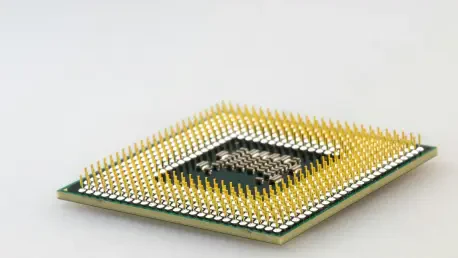In an era where technology underpins global power, the semiconductor industry stands as a critical battleground, shaping everything from consumer electronics to advanced military systems, and a recent investigation by the Select Committee on China has revealed a troubling trend. Led by Chairman John Moolenaar (R-MI) and Ranking Member Raja Krishnamoorthi (D-IL), the probe shows that American and allied companies are significantly contributing to the rapid advancement of China’s semiconductor capabilities. This isn’t merely a matter of business transactions but a complex issue touching on national security, economic dominance, and ethical boundaries. The report details how prominent firms are supplying cutting-edge equipment to Chinese entities, many of which are intertwined with state and military interests, raising alarms about the broader implications of such dealings. As the technological rivalry between the U.S. and China intensifies, understanding the scope and consequences of these actions becomes paramount for policymakers and industry leaders alike.
The Financial Nexus of Semiconductor Sales
A Market Too Lucrative to Ignore
The financial ties between U.S. and allied semiconductor equipment manufacturers and the Chinese market are nothing short of staggering, painting a picture of deep economic interdependence that poses significant risks. In 2024, major players like Tokyo Electron from Japan derived 44% of their revenue from China, while U.S.-based Lam Research and KLA reported 42% and 41%, respectively. ASML from the Netherlands and Applied Materials from the U.S. each saw 36% of their earnings tied to this market. These figures highlight a reliance that has grown dramatically in recent years, with sales to Chinese state-owned enterprises (SOEs) jumping from $9.5 billion in 2022 to a staggering $26.2 billion in 2024. This sharp increase, representing a shift from 11% to 27% of overall revenue, underscores how integral the Chinese market has become to these companies’ bottom lines. However, this financial dependency raises critical questions about whether short-term profits are being prioritized over long-term strategic interests, especially given the geopolitical tensions at play.
Beyond the raw numbers, the nature of these transactions reveals a troubling dynamic that could undermine global economic stability if left unchecked. The massive revenue streams from Chinese SOEs, which now account for 69% of the firms’ China-based earnings, indicate a market that is not just a customer but a strategic player with ties to state agendas. These enterprises often operate under the influence of the Chinese Communist Party (CCP), meaning that funds funneled through equipment sales could indirectly support policies and initiatives counter to U.S. and allied interests. The financial allure of the Chinese market is evident, yet it creates a vulnerability for companies that may find themselves caught between profit motives and the broader implications of empowering a rival. As these firms navigate this lucrative but risky terrain, the potential for economic leverage to shift in China’s favor looms large, demanding a closer examination of how such dependencies are managed in a competitive global landscape.
Profit Over Principle
Delving deeper into the financial motivations, it becomes clear that the drive for profit often overshadows the potential geopolitical fallout of these semiconductor equipment sales. Companies like Applied Materials and Lam Research have built substantial portions of their business models around the Chinese market, where demand for advanced manufacturing tools continues to surge. This isn’t merely a response to market opportunity but a calculated strategy to maintain competitive edges in an industry where margins are tight and innovation costs are high. The 2024 data showing billions in sales to entities with direct or indirect state backing illustrates a willingness to engage with customers whose ultimate goals may conflict with global security norms. Such decisions, while financially sound in the short term, risk creating a dependency that could be exploited by China to pressure firms into further concessions or technology transfers down the line.
Moreover, the financial entanglements reveal a broader systemic issue within the global semiconductor supply chain, where economic incentives can blur ethical and strategic lines. The rapid escalation of sales to Chinese SOEs suggests that many firms are prioritizing immediate revenue over the potential long-term consequences of enhancing a competitor’s capabilities. This trend is particularly concerning given the bipartisan alarm expressed in the Select Committee’s report, which critiques the logic of profiting from a market that simultaneously modernizes its military and challenges democratic values. The financial nexus, while lucrative, thus serves as a double-edged sword, offering short-term gains but potentially compromising the very technological leadership that these companies represent on the global stage. Addressing this imbalance will require more than just corporate restraint; it demands coordinated policy interventions to realign priorities.
Security Risks and Military Implications
Arming a Potential Adversary
The security implications of American and allied firms supplying semiconductor manufacturing equipment to China are profound, raising the specter of advanced technology being turned against the very nations that developed it. The Select Committee’s investigation highlights that several Chinese entities, flagged by the U.S. government as national security risks, are among the top customers of these equipment makers. Notable among them are associates of Huawei, a company long associated with concerns over espionage and military ties. The advanced chips produced using this equipment could power artificial intelligence and high-performance computing systems integral to the People’s Liberation Army’s push for “intelligentized” warfare. Such capabilities, if deployed in future conflicts, could directly threaten American and allied servicemembers, transforming commercial transactions into potential strategic liabilities that undermine global safety.
Compounding this issue is the direct linkage between these sales and China’s military-industrial complex, which thrives on technological advancements to bolster its global standing. The report details how five specific Chinese entities, tied to intelligence and defense operations, have leveraged purchased equipment to enhance their capabilities. This isn’t a hypothetical risk but a tangible concern, as the technology in question enables cutting-edge applications that could shift the balance of power in military engagements. The notion that tools sold for profit might one day be used in systems targeting allied forces underscores the urgency of reevaluating export policies. As China continues to integrate these advancements into its strategic arsenal, the line between commerce and conflict blurs, necessitating a robust response to prevent further erosion of security advantages held by the U.S. and its partners.
A Threat to Global Trade Dynamics
Beyond immediate military risks, China’s ambition to achieve semiconductor self-sufficiency poses a significant threat to global economic and security frameworks, with far-reaching consequences. The investigation reveals that the People’s Republic of China aims to create a vertically integrated chip manufacturing industry, rendering it immune to export controls imposed by the U.S. and its allies. If successful, this strategy could position China as a dominant force in both legacy and advanced chip markets, effectively sidelining Western influence in a sector critical to modern economies. Such a shift would not only disrupt trade dynamics but also grant China unprecedented leverage over global supply chains, impacting everything from consumer goods to defense technologies in ways that could marginalize allied nations.
Furthermore, the pursuit of self-reliance in semiconductors by China represents a calculated move to neutralize one of the few remaining chokepoints where the U.S. and its partners hold a competitive edge. The Select Committee’s findings emphasize that allowing this ambition to go unchecked risks ceding technological leadership to a rival whose interests often run counter to democratic principles. The economic security of allied nations hangs in the balance, as a China-dominated semiconductor market could dictate terms that undermine fair competition and innovation. Addressing this looming challenge requires more than just tightened controls; it demands a concerted effort to bolster domestic capabilities and foster international cooperation to maintain a strategic advantage in this pivotal industry before the window of opportunity narrows further.
Ethical and Global Consequences
Enabling Oppression Through Technology
The ethical ramifications of supplying semiconductor equipment to China are as troubling as the security risks, casting a harsh light on the unintended consequences of these business dealings. The Chinese Communist Party has a well-documented history of utilizing high-performance computing and artificial intelligence for domestic surveillance, often targeting minority groups and dissenters in ways that violate fundamental human rights. The Select Committee’s report underscores that the advanced technology provided by American and allied firms indirectly enables such oppression, equipping the regime with tools to expand its digital authoritarianism both at home and abroad. This complicity, even if unintentional, raises profound moral questions about the responsibility of corporations to consider the end-use of their products beyond mere profit margins in a globalized economy.
Additionally, the export of such technology contributes to a broader pattern of enabling regimes that prioritize control over individual freedoms, a trend with global implications. The capabilities enhanced by semiconductor equipment allow for sophisticated monitoring systems that can be exported as models of governance to other nations, spreading authoritarian practices under the guise of technological advancement. This dynamic places companies in a difficult position, balancing shareholder expectations against the ethical fallout of their sales. The investigation’s findings serve as a stark reminder that technology is not neutral; its applications can either uphold or undermine democratic values depending on who wields it. As such, there is a pressing need for firms to adopt stricter due diligence processes to ensure their innovations do not become instruments of repression in the hands of adversarial powers.
Policy Gaps and Strategic Evasion
On the international stage, discrepancies in export control policies among allied nations exacerbate the challenges of curbing China’s semiconductor growth, creating loopholes that undermine collective efforts. While the U.S. has implemented stringent restrictions on technology exports to Chinese entities, firms from the Netherlands and Japan, such as ASML and Tokyo Electron, have increased their revenues from the same market by capitalizing on less rigorous regulations. The Select Committee’s investigation points out that this inconsistency allows China to access critical equipment through alternative channels, effectively diluting the impact of U.S. measures. Such a fragmented approach among allies not only weakens the overall strategy but also highlights the urgent need for harmonized policies to close these gaps and present a united front against technology leakage.
Equally concerning is evidence of China’s strategic efforts to circumvent existing controls, revealing a calculated approach to building its technological arsenal. The report notes that the CCP is stockpiling lithography equipment at sophistication levels just below current restriction thresholds, positioning itself to advance capabilities without triggering immediate sanctions. This tactic of evasion underscores the adaptive nature of China’s strategy, which exploits policy disparities and regulatory blind spots to sustain its semiconductor ambitions. Addressing this challenge requires more than unilateral action; it demands enhanced coordination among allies to align export standards and expand oversight mechanisms. Only through such collaborative efforts can the international community hope to prevent further erosion of technological advantages and safeguard shared security and ethical interests.
Reflecting on a Strategic Misstep
Looking back, the extensive involvement of American and allied companies in bolstering China’s semiconductor industry through equipment sales marked a critical oversight with lasting repercussions for global security and ethical standards. The investigation by the Select Committee on China exposed how billions in revenue, driven by a shortsighted focus on profit, empowered a rival’s military modernization and authoritarian practices. These actions, documented in stark financial and strategic terms, contributed to a landscape where advanced technology risked being weaponized against democratic interests. The bipartisan concern voiced by leaders like Chairman Moolenaar and Ranking Member Krishnamoorthi reflected a shared recognition of the gravity of this miscalculation, as corporate decisions inadvertently fueled a geopolitical challenge. Moving forward, the path lies in implementing tighter, unified export controls, fostering innovation within allied nations, and prioritizing long-term security over immediate financial gains. A renewed commitment to international cooperation and strategic foresight offers the best hope to reclaim technological leadership and uphold shared values in an increasingly contested domain.









